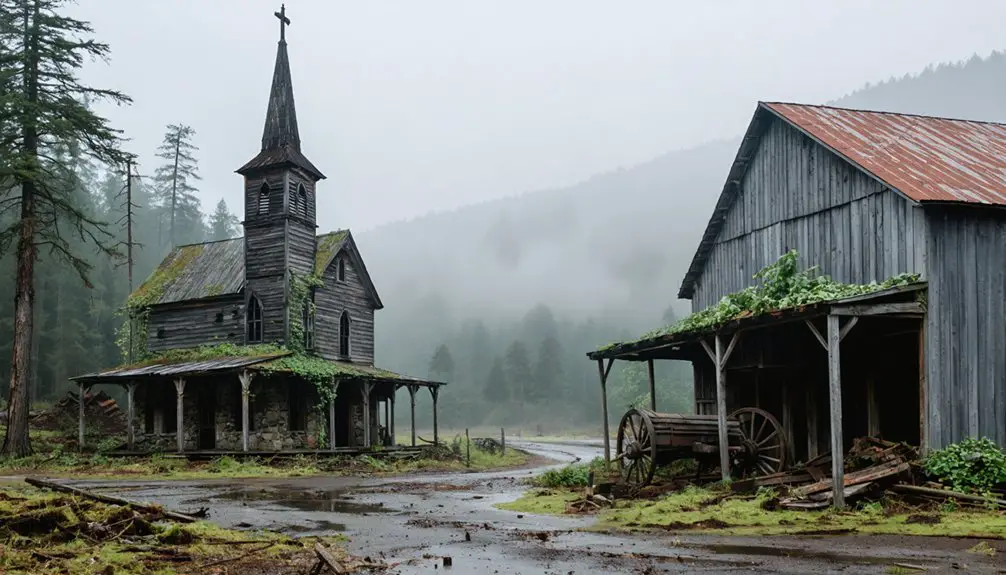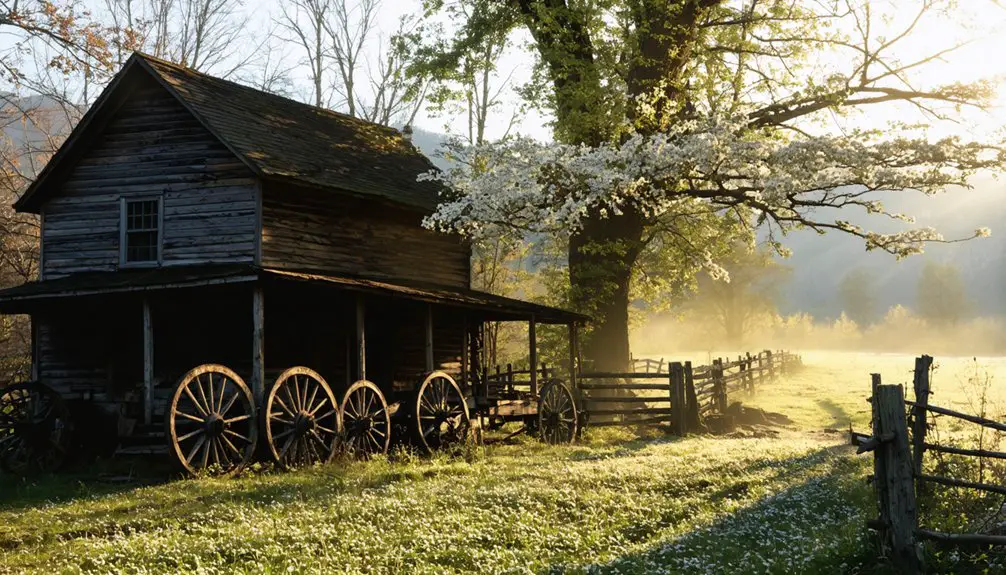You’ll find the abandoned settlement of Wasp nestled in Tennessee’s Wolf Creek Valley, where it once thrived with 100 residents in the late 1800s. Named after a solitary wasp species, this self-sufficient community included a post office, gristmill, and school before its abandonment in the 1930s. Today, you can explore the stone foundations and agricultural terraces preserved within Cherokee National Forest. The site’s fascinating transformation from logging town to ghost town holds many untold stories.
Key Takeaways
- Wasp was an early 20th-century settlement in Tennessee’s Wolf Creek Valley that became abandoned in the 1930s.
- The community once had approximately 100 residents and featured a post office, gristmill, and school.
- Located in Cherokee National Forest at 2,500 feet elevation, Wasp’s ruins include stone foundations and agricultural terraces.
- The town’s decline occurred when U.S. Forest Service interventions and environmental challenges forced residents to relocate.
- Visitors can explore the historic site, but should prepare for rugged conditions as no modern facilities exist.
The Rise and Fall of an Appalachian Settlement

While many Appalachian settlements flourished and faded over time, Wasp’s story uniquely captures the challenges faced by mountain communities in late 19th-century Tennessee.
Like the solitary wasp species that would later inspire its name, the residents of this remote settlement demonstrated remarkable independence through subsistence farming and self-sufficient living in Cocke County’s Wolf Creek Valley.
Despite their adaptation to mountain life, Wasp’s residents couldn’t escape the environmental challenges that would ultimately seal their fate.
By the early 20th century, widespread logging devastated the Wolf Creek watershed, threatening their agricultural way of life.
The U.S. Forest Service‘s intervention in the 1930s, while aimed at restoring the damaged ecosystem, forced residents to abandon their homes, similar to how changing transportation systems contributed to the decline of many Tennessee ghost towns.
Today, at over 2,500 feet in the Bald Mountains, Wasp’s ruins stand as a monument to the delicate balance between human settlement and environmental preservation.
Life in Early 20th Century Wasp
As Wasp entered the 20th century, its bustling community infrastructure served roughly 100 residents.
At the dawn of 1900, Wasp flourished as a close-knit mountain hamlet, sustaining a hardy population of one hundred souls.
You’d find a post office connecting you to neighboring towns, while the local gristmill processed your grain harvests. Your children would attend the community school, where education methods focused on basic curriculum suited to rural Appalachian life. Like the early colonial merchants’ descendants, most families maintained modest wealth through agriculture and trade. The community valued civic-mindedness as a core principle of daily life.
Agricultural practices dominated daily routines, with your family likely maintaining a subsistence farm supplemented by livestock.
You’d source water from Wolf Creek, rely on timber from surrounding forests for heat and construction, and gather with neighbors at the mission house for worship and social events.
Living at 2,500 feet elevation meant you’d need to be self-reliant, developing skills to thrive in geographic isolation until the U.S. Forest Service’s acquisition in 1935 ended the community’s era.
Natural Beauty and Geographic Features
The pristine wilderness of Wasp rises 2,500 feet above sea level in Cocke County’s eastern reaches, where Wolf Creek carves through the western Bald Mountains.
You’ll find yourself surrounded by the Cherokee National Forest‘s dense hardwoods, where mountain ecology thrives in the untamed landscape. The area’s native Potter Wasps construct distinctive clay nests among the forest vegetation. Visitors can still spot remnants of the area’s logging activities from before its abandonment in the 1930s.
The watershed restoration efforts of the 1930s have transformed this once-logged valley into a natural paradise.
Here’s what you’ll discover in this rugged terrain:
- Wolf Creek’s crystal waters flowing northward to the French Broad River
- Walnut Mountain’s majestic 4,300-foot summit along the Appalachian Trail
- Network of forest service roads leading to Round Mountain campground
- Rich biodiversity supported by steep slopes and rocky outcrops
You’re free to explore this wilderness via hiking trails and forest roads, all while experiencing the raw beauty of Appalachian nature.
Preserving the Past: Historical Ruins Today
Hidden within this pristine wilderness lie remarkable archaeological treasures from Wasp’s early 20th-century community. You’ll find stone foundations, chimney remains, and agricultural terraces that showcase the archaeological significance of one of the most complete early Appalachian settlement sites.
The United States Forest Service acquired Wasp in the 1930s, and today the Cherokee National Forest carefully manages these historic ruins. Similar to Elkmont, the area transformed from a logging operation site into an abandoned town.
Conservation challenges include protecting the delicate stone structures while allowing natural vegetation to stabilize the soil around old homesteads. Unlike the restored cabins at Elkmont, Wasp’s preservation focuses on maintaining archaeological integrity. While some areas were completely demolished, nineteen historic buildings remain preserved at Elkmont for visitors to explore.
You can access the site via forest service roads, where interpretive signage helps you understand the historical context of this unique community that stands as a symbol of early Appalachian life.
Exploring the Ghost Town: Visitor’s Guide
Planning a visit to Wasp requires careful preparation and a spirit of adventure.
You’ll find this hidden gem tucked away in the Wolf Creek Valley of eastern Tennessee, accessible only through rural access routes that wind through forested hillsides.
Before commencing your journey, consider these essential visitor tips:
- Pack supplies for rugged exploration – there aren’t any facilities or amenities on site.
- Bring a camera to capture the haunting remnants of early rural Tennessee life.
- Wear sturdy boots for traversing unstable ground and foundation stones.
- Plan your visit during fair weather, as seasonal conditions affect accessibility.
The end of October is an ideal time to visit, when cooler temperatures and seasonal changes create a particularly atmospheric setting.
You’re free to explore the abandoned homes and logging artifacts at your own pace, but remember to tread carefully through this untamed slice of Appalachian history. Like the nearby historic structures at Elkmont, many buildings have fallen into disrepair over the decades.
Frequently Asked Questions
Are There Any Reported Paranormal Activities or Ghost Sightings in Wasp?
You won’t find documented ghost encounters or spectral sightings in Wasp. Unlike other Tennessee ghost towns with rich paranormal folklore, there’s no verified evidence of supernatural activity in this forest-managed site.
What Happened to the Residents After They Were Forced to Leave?
You’ll find that after their community displacement, residents were forced to integrate into nearby towns, seek new jobs beyond farming, and adapt their lives within Cocke County or wider eastern Tennessee.
Were There Any Schools or Churches in the Wasp Community?
You won’t find clear records of formal schools or churches in historical documents. While community gatherings and education likely occurred, they probably took place in homes rather than dedicated buildings.
What Was the Peak Population of Wasp During Its Prime Years?
While Wasp’s history and economy suggest a thriving rural community, you won’t find exact peak population figures. Based on similar Appalachian farming settlements, it likely peaked at fewer than 200 residents.
Are Metal Detecting and Artifact Collection Allowed at the Ghost Town Site?
You’ll need proper permits for metal detecting due to strict regulations. Without state archaeological permits and landowner permission, you can’t legally collect artifacts or disturb the ground at protected sites.
References
- https://en.wikipedia.org/wiki/Wasp
- https://www.tnmagazine.org/19-ghost-towns-in-tennessee-that-are-not-underwater/
- https://historycollection.com/wont-believe-10-american-ghost-towns/
- https://en.wikipedia.org/wiki/List_of_ghost_towns_in_Tennessee
- https://kids.kiddle.co/List_of_ghost_towns_in_Tennessee
- https://www.wikiwand.com/en/articles/List_of_ghost_towns_in_Tennessee
- https://theweek.com/politics/1003258/the-wasps-died-out-as-a-distinctive-class
- https://www.nps.gov/parkhistory/online_books/grsm/4/intro.htm
- https://www.ivy-style.com/protestant-deformation-neurotic-wasps-1990.html
- https://birdwatchinghq.com/wasps-and-hornets-in-tennessee/



